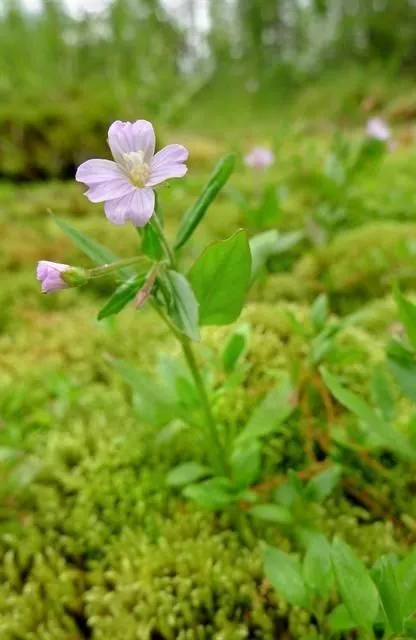
Author: Rchb.
Bibliography: Icon. Fl. Germ. Helv. 2: 73 (1838)
Year: 1838
Status: accepted
Rank: species
Genus: Epilobium
Vegetable: False
Observations: Subarctic Eurasia, Subarctic and Temp. America
Hornemann’s willowherb, scientifically known as Epilobium hornemannii, is a fascinating member of the Onagraceae family. This plant was first described in the bibliographic reference Icon. Fl. Germ. Helv. 2: 73 in the year 1838 by the author Rchb., a prominent botanist of his time.
This species thrives predominantly in subarctic regions of both Eurasia and America, as well as in temperate areas across North America. It is well-adapted to the chilly climates of these regions, showcasing the plant’s resilience and versatility.
The Hornemann’s willowherb is notable for its ecological role in these subarctic climates, often found in habitats that range from moist, grassy meadows to the banks of freshwater streams. This plant plays a critical part in these ecosystems, providing food and habitat shelter for a range of local wildlife.
The genus Epilobium within which Hornemann’s willowherb is categorized, is known for its characteristic flowering patterns and distinctive willow-like appearance, which explains the commonality of the name “willowherb”. It typically features elongated, lanceolate leaves, and its flowers exhibit striking hues, making it a moderate yet attractive presence in its habitat.
Researchers and botanists show a keen interest in Epilobium hornemannii due to its environmental adaptability and the role it plays in maintaining the biodiversity and stability of its native ecosystems. Its presence is often an indicator of healthy, well-functioning wetland systems and it can be a subject of study for understanding ecological reactions to climatic conditions.
With its beautiful flowers and crucial ecological contributions, the Hornemann’s willowherb is certainly a noteworthy plant within the Onagraceae family.
Eng: hornemann’s willowherb
Swe: fjälldunört, pohjanhorsma, hornemanns dunört
Fin: pohjanhorsma
Nob: setermjølke
Nno: setermjølke
Sme: várrehorbmá, davvehorbmá
Fra: épilobe de hornemann, épilobe d’hornemann
En: Hornemann’s willowherb, Hornemann hummingbird trumpet, Hornemann’s willowweed
Fi: Pohjanhorsma
Fr: Épilobe de Hornemann, Épilobe d’Hornemann
Se: Várrehorbmá, Davvehorbmá
Nb: Setermjølke
Nn: Setermjølke
Sv: Fjälldunört, Pohjanhorsma, Hornemanns dunört
Taken Oct 2, 2022 by Ilaria Mosti (cc-by-sa)
Taken Jul 2, 2022 by SeppOlawi XII (cc-by-sa)
Taken Dec 26, 2014 by EOL − podiceps (cc-by-nc)
Taken Dec 26, 2014 by EOL − podiceps (cc-by-nc)
Taken Jan 1, 1900 by EOL − Encyclopedia of Life (cc-by-nc)
Taken Jun 29, 2022 by SeppOlawi XII (cc-by-sa)
Taken Oct 6, 2020 by Leto Adam (cc-by-sa)
Taken Jan 1, 1900 by EOL − Encyclopedia of Life (cc-by-nc)
Taken Jan 1, 1900 by EOL − Encyclopedia of Life (cc-by-nc)
Taken Jan 1, 1900 by EOL − Encyclopedia of Life (cc-by-nc)
Taken Jan 1, 1900 by EOL − Encyclopedia of Life (cc-by-nc)
Taken Jan 1, 1900 by EOL − C. Webber (cc-by-nc-sa)
Growth habit: Forb/herb
Ph maximum: 6.5
Ph minimum: 5.5
Light: 6
Atmospheric humidity: 9
Soil nutriments: 5
Family: Myrtaceae Author: (F.Muell.) K.D.Hill & L.A.S.Johnson Bibliography: Telopea 6: 402 (1995) Year: 1995 Status:…
Family: Rubiaceae Author: Pierre ex A.Froehner Bibliography: Notizbl. Bot. Gart. Berlin-Dahlem 1: 237 (1897) Year:…
Family: Sapindaceae Author: Koidz. Bibliography: J. Coll. Sci. Imp. Univ. Tokyo 32(1): 38 (1911) Year:…
Family: Asteraceae Author: A.Gray Bibliography: Pacif. Railr. Rep.: 107 (1857) Year: 1857 Status: accepted Rank:…
Family: Fabaceae Author: Medik. Bibliography: Vorles. Churpfälz. Phys.-Ökon. Ges. 2: 398 (1787) Year: 1787 Status:…
Family: Aspleniaceae Author: (Cav.) Alston Bibliography: Bull. Misc. Inform. Kew 1932: 309 (1932) Year: 1932…